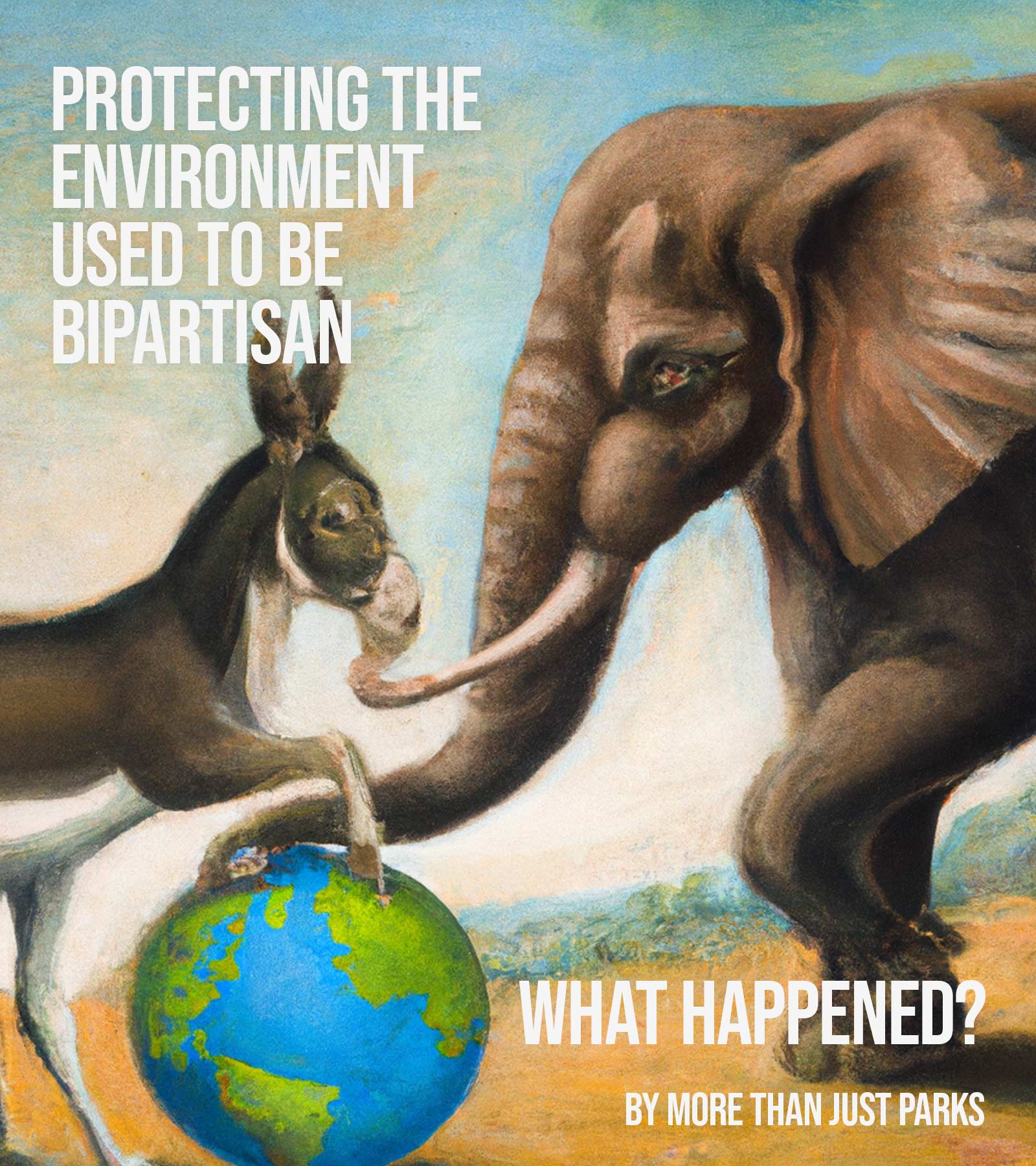
Article Summary: Republicans On Climate Change
Once upon a time, it was the Grand Old Party that led America and the world when it came to conservation and environmentalism. This was followed by a golden era of environmental activism with both sides working together to ensure a healthier planet for all. Then came a darker period.
That era started in the early 1980s and continues to this day. As CNN notes, today the party that once led the world on environmentalism is mired in a climate bind – and likely will be for the foreseeable future.
Why does this matter? According to the United Nations Report On Climate Change, the world is likely to pass a dangerous temperature threshold within the next 10 years, pushing the planet past the point of catastrophic warming — unless nations drastically transform their economies and immediately transition away from fossil fuels
How did the party which led the way on conservation lose its way on the environment? How did the party of Roosevelt go from practicing conservation to ignoring devastation? And how can we persuade the next generation to accept the science of climate change and adopt concrete solutions to this problem?

This article is part of our important series on Environmental Heroes.
Republicans On Climate Change
A Republican President Created The First National Park
The man who gave America its first national park was a Republican President. President Ulysses S. Grant played a significant role in the conservation and establishment of the first national park in the United States, Yellowstone National Park.
In 1871, Congress allocated $40,000 to finance an expedition led by the U.S. Geological Survey to explore the relatively unknown area of Yellowstone. The expedition brought back valuable information about the region and included 3D stereographic images of the stunning landscape.
Based on the findings of the expedition, President Grant signed the Yellowstone National Park Protection Act on March 1, 1872, officially establishing Yellowstone as the first national park in the world. This historic step marked the beginning of the concept of national parks, which aimed to preserve natural wonders and provide public enjoyment and appreciation of these areas.
Theodore Roosevelt later referred to Grant as the “father of the national parks” for his role in this crucial conservation effort.
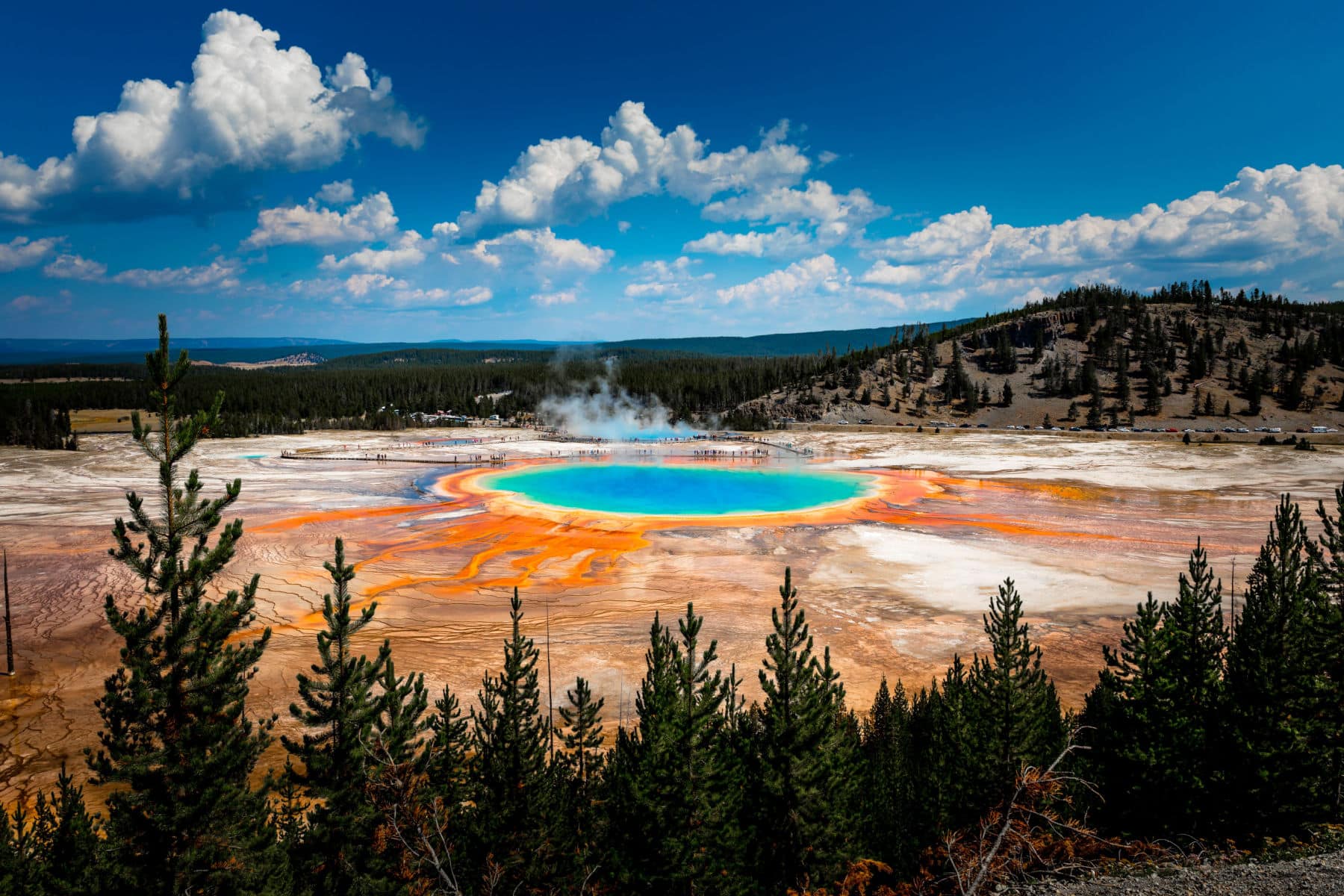
Grant’s Conservation Efforts Extended Beyond National Parks
Moreover, President Grant’s conservation efforts extended beyond America’s national parks. In 1868, he designated the Pribilof Islands in Alaska as a reserve for the northern fur seal. These seals had been heavily over-hunted for their valuable pelts, leading to a dramatic decline in their population.
Grant’s action marked one of the first instances of protecting marine mammals and recognizing the importance of preserving their habitats.
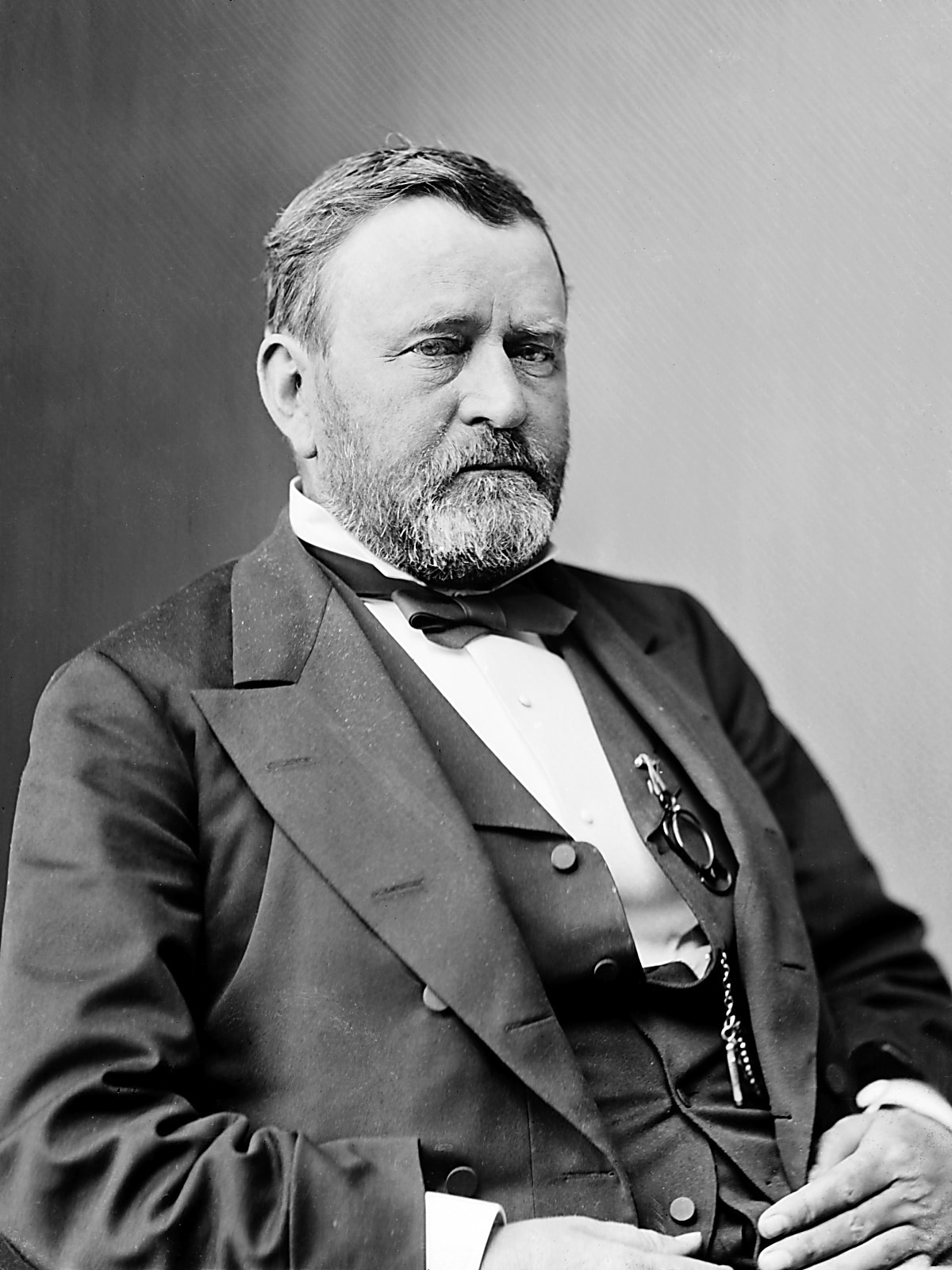
America’s First Great Conservation President Was A Republican
Theodore Roosevelt’s conservation legacy is both profound and enduring, making him one of the most significant figures in American conservation history. As the 26th President of the United States, serving from 1901 to 1909, Roosevelt left a remarkable impact on environmental protection and natural resource conservation.
Roosevelt was the first President to truly champion the issue of conservation. And, believe it or not, he was a Republican. His conservation policies and actions laid the foundation for modern environmentalism in the United States.
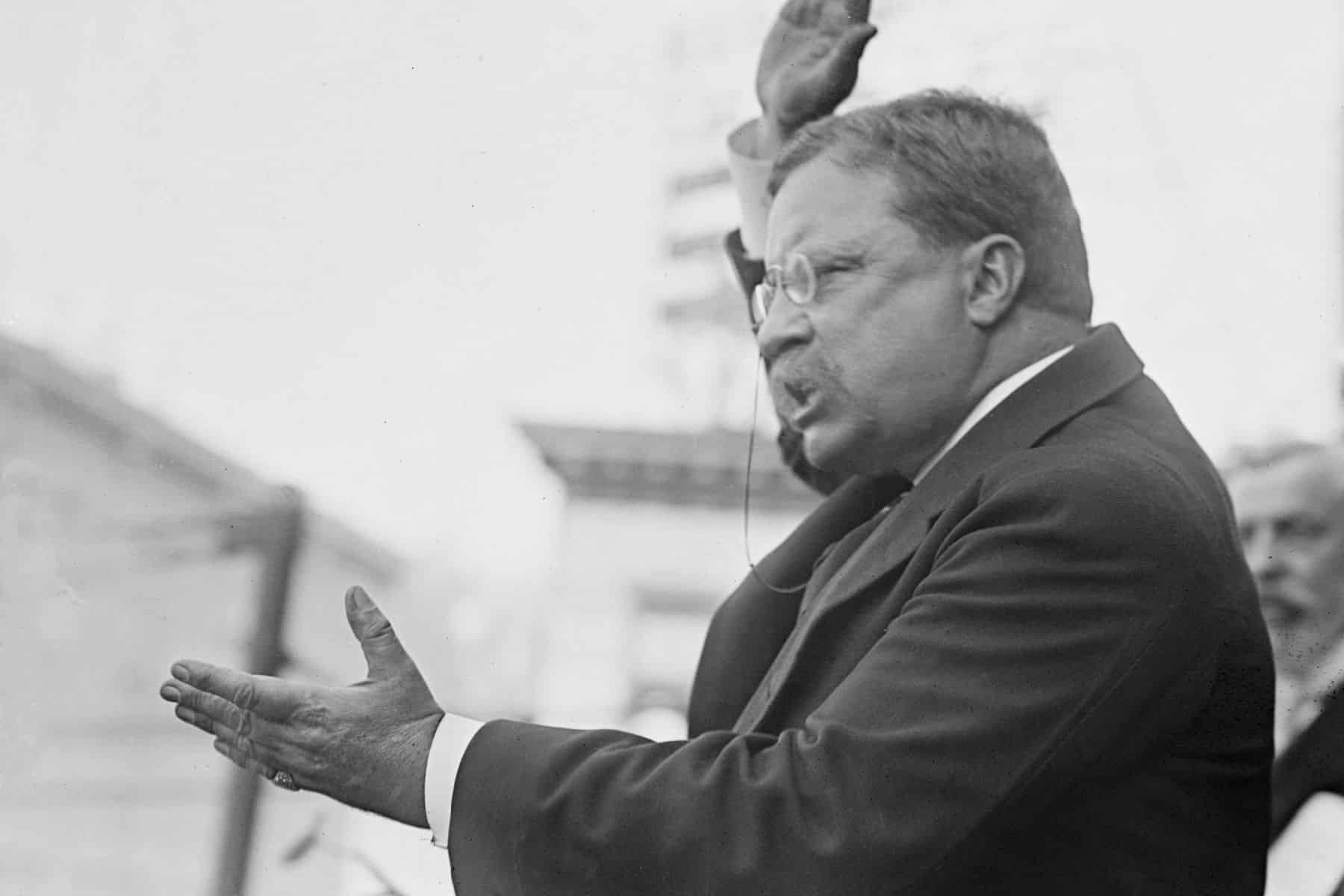
“We have become great because of the lavish use of our resources. But the time has come to inquire seriously what will happen when our forests are gone, when the coal, the iron, the oil, and the gas are exhausted, when the soils have still further impoverished and washed into the streams, polluting the rivers, denuding the fields and obstructing navigation.”
-theodore roosevelt
Roosevelt’s Conservation Legacy
Here are some key aspects of Theodore Roosevelt’s conservation legacy:
- National Parks and Public Lands: Roosevelt recognized the importance of preserving natural landscapes for future generations. During his presidency, he established five national parks, including Crater Lake and Wind Cave, and signed the Antiquities Act into law, which empowered presidents to designate national monuments to protect significant cultural, historical, and natural sites. He used this authority to establish 18 national monuments, including the Grand Canyon. Under his administration, over 230 million acres of public land were set aside for conservation purposes.
- Forest Conservation: Roosevelt believed in the sustainable management of forests and the protection of natural resources. In 1905, he transferred the management of federal forest reserves from the Interior Department to the Agriculture Department, under Gifford Pinchot, a close ally and pioneer in conservation forestry. This move helped establish the United States Forest Service, which focused on responsible forestry practices and conservation of forest resources.
- National Wildlife Refuge System: Roosevelt was an avid hunter and naturalist, but he also recognized the importance of preserving wildlife and their habitats. He played a significant role in expanding the National Wildlife Refuge System, setting aside protected areas to conserve and restore wildlife populations.
- Conservation Diplomacy: Roosevelt’s conservation vision extended beyond U.S. borders. He advocated for wildlife and habitat conservation on the international stage, using diplomacy to establish wildlife sanctuaries, promote responsible hunting practices, and protect natural resources worldwide.
- Conservation Ideology: Roosevelt’s conservation philosophy emphasized the responsible use of natural resources for the public good. He believed in a balanced approach to conservation, one that allowed for economic development while also safeguarding the environment for future generations. His belief in stewardship and active management of resources laid the groundwork for modern conservation practices.
- Legacy in Environmental Awareness: Beyond his tangible contributions to conservation, Roosevelt’s presidency helped raise public awareness about the importance of protecting the environment. He was a passionate advocate for preserving nature’s beauty and resources, inspiring a new generation of conservationists and setting the stage for future environmental movements.
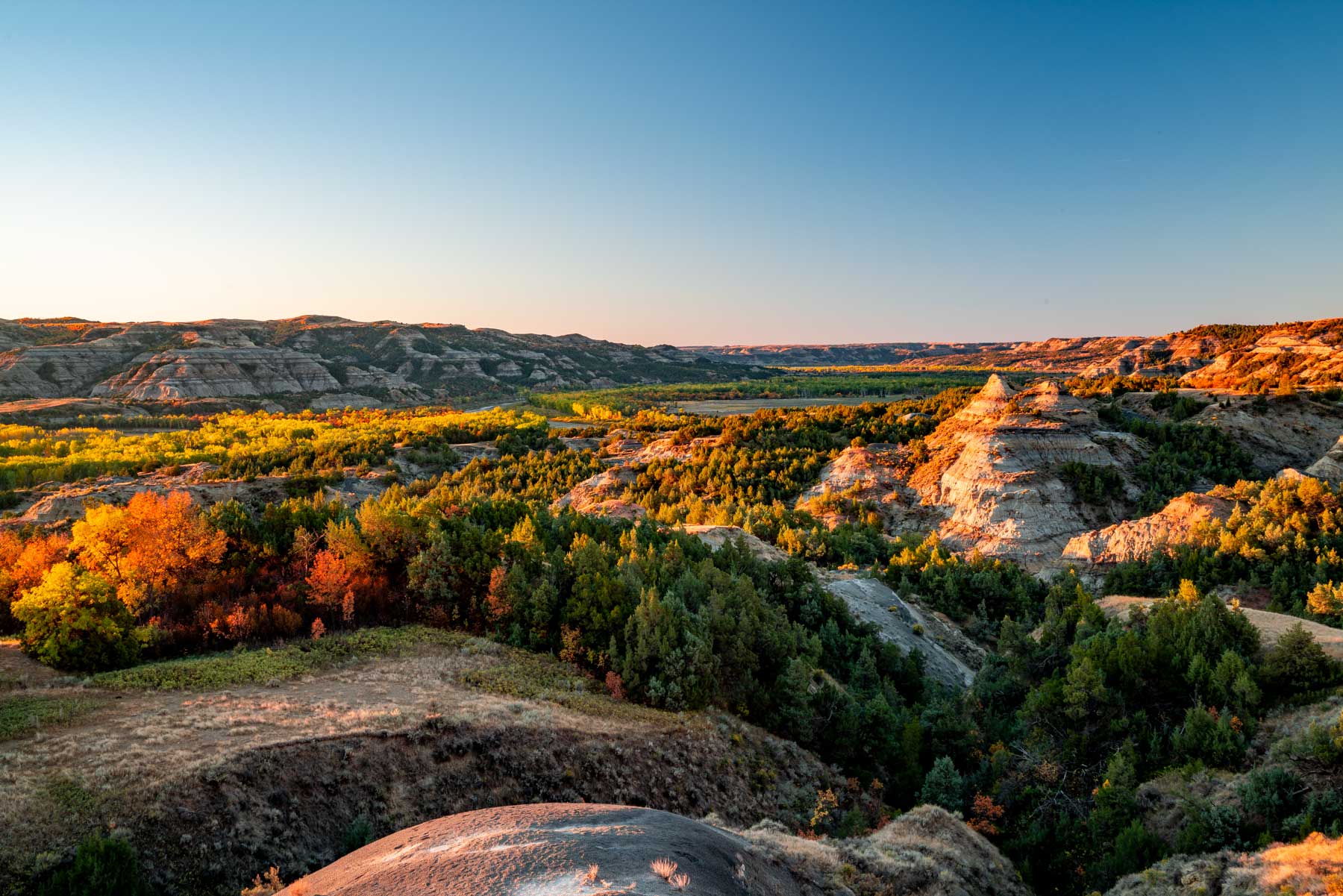
A More Recent Republican Conservation President Was Richard M. Nixon
The Defenders of Wildlife established their list of presidents from both political parties who have been champions of conservation. Of the men who followed Theodore Roosevelt into the White House, only one Republican makes their list. His name is Richard M. Nixon.
President Nixon’s environmental record is often surprising to many people, given the current political climate and the negative public perceptions of his administration. Despite being associated with controversial events, such as the Watergate scandal, Nixon made significant contributions to environmental policy during his presidency.
During his first State of the Union address in 1970, Richard Nixon declared the environment as the defining issue of the new decade and emphasized the need to address the damages done to the air, land, and water.
Following this commitment, his administration took several key steps to address environmental issues, which had a lasting impact on American environmental policy.
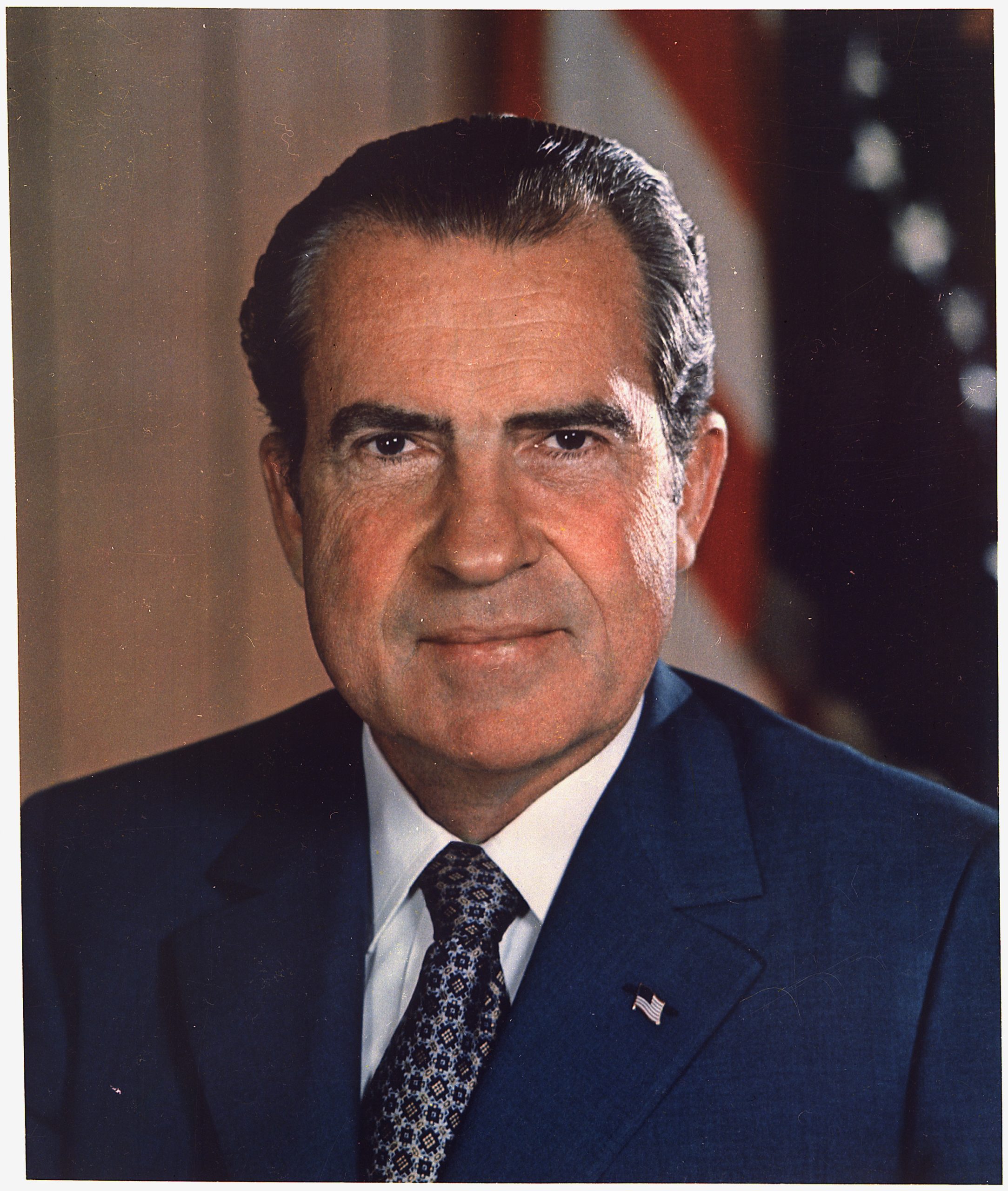
President Nixon’s Environmental Legacy
Here are some of the major environmental policies and initiatives that President Nixon initiated:
- National Environmental Policy Act (NEPA): Signed into law on January 1, 1970, NEPA requires federal agencies to consider the environmental impact of their actions and involve the public in decision-making processes related to major projects.
- Creation of the Environmental Protection Agency (EPA): The EPA was established in December 1970 to consolidate various federal environmental responsibilities into one agency. The EPA is tasked with enforcing environmental regulations and addressing environmental issues comprehensively.
- Clean Air Act of 1970: This landmark legislation aimed to control air pollution by setting emission standards for various pollutants and establishing requirements for state implementation plans.
- National Oceanic and Atmospheric Administration (NOAA): The NOAA was created in 1970 to focus on the management and conservation of marine and coastal resources and the study of the atmosphere and oceans.
- Endangered Species Act (ESA): Signed into law in December 1973, the ESA provides protection for threatened and endangered species and their habitats, aiming to prevent extinction and promote recovery efforts.
- Marine Mammal Protection Act (MMPA): Enacted in 1972, the MMPA protects marine mammals from being killed, captured, or harassed by humans and sets regulations for marine mammal conservation.
- Legacy of Parks program: This program was established to convert over 80,000 acres of government property into recreational use, creating 642 new parks for public enjoyment.
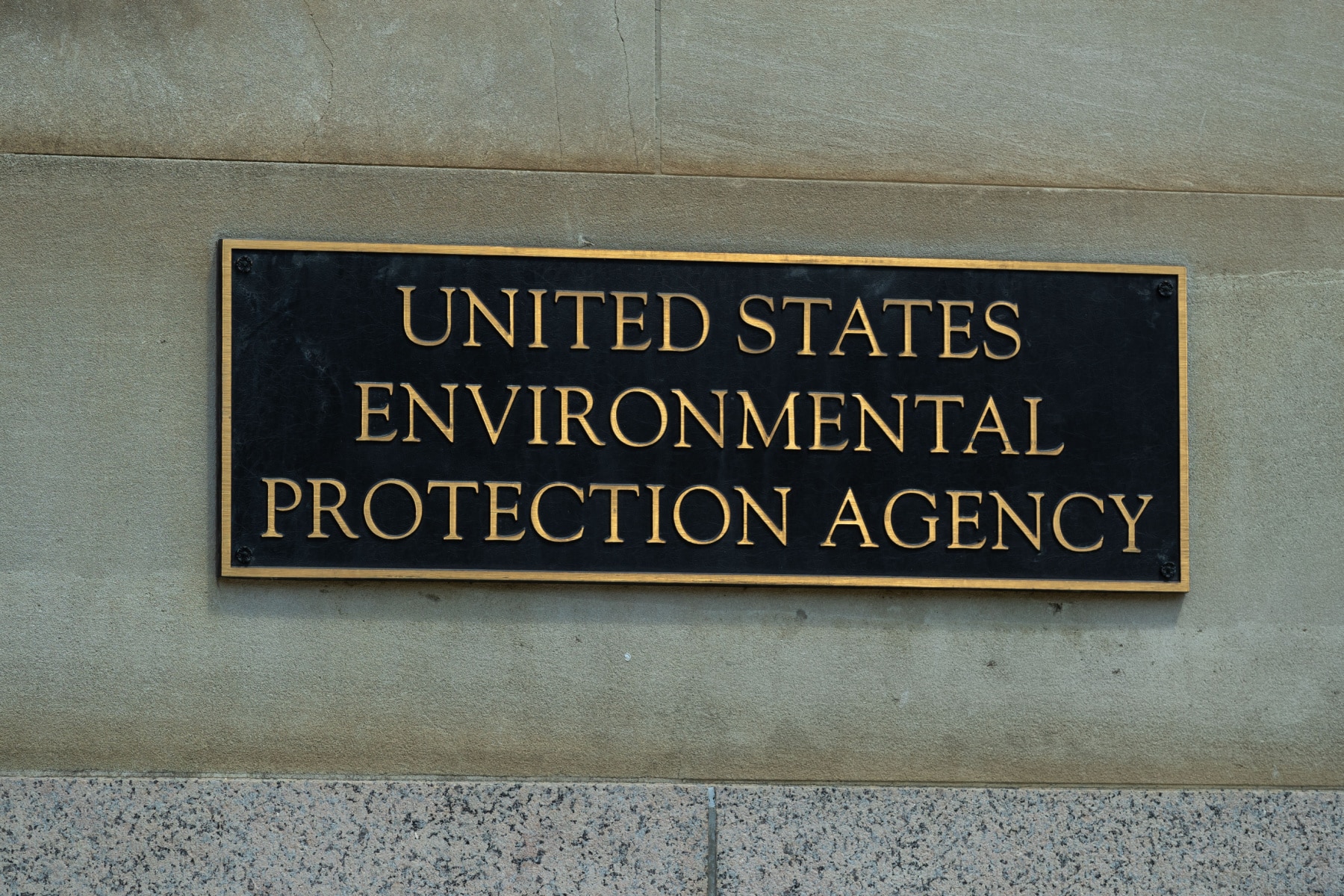
A Republican President Helped To Shape Environmental Governance
These environmental policies and initiatives helped shape modern environmental governance in the United States and demonstrated a commitment to addressing environmental challenges at a time when bipartisan support was achieved.
Nixon’s environmental legacy highlights the possibility of politicians finding common ground and working together on important issues such as protecting the environment for future generations.
According to Russell Train, 2nd EPA Administrator & President of the World Wildlife Fund, Environmental Protection represented the single most significant area of domestic policy accomplishment of the Nixon Administration.
“The great question of the Seventies is…shall we make our peace with nature and begin to make reparations for the damage we have done to our air, to our land, and to our water,”
-President Richard nixon
Another Republican President Supported Environmental Protection
Gerald Rudolph Ford was the only American to become president who was neither elected to the presidency or the vice presidency.
Ford was appointed by Richard Nixon to replace Vice President Spiro Agnew. Agnew had to resign as part of a plea bargain agreement. In 1973, he was investigated by the United States Attorney for the District of Maryland on suspicion of criminal conspiracy, bribery, extortion and tax fraud.
After months of maintaining his innocence, Agnew pleaded no contest to a single felony charge of tax evasion and resigned from office.
The Watergate Scandal led to Nixon’s own resignation a year later. Ford replaced him becoming the nation’s 38th president.
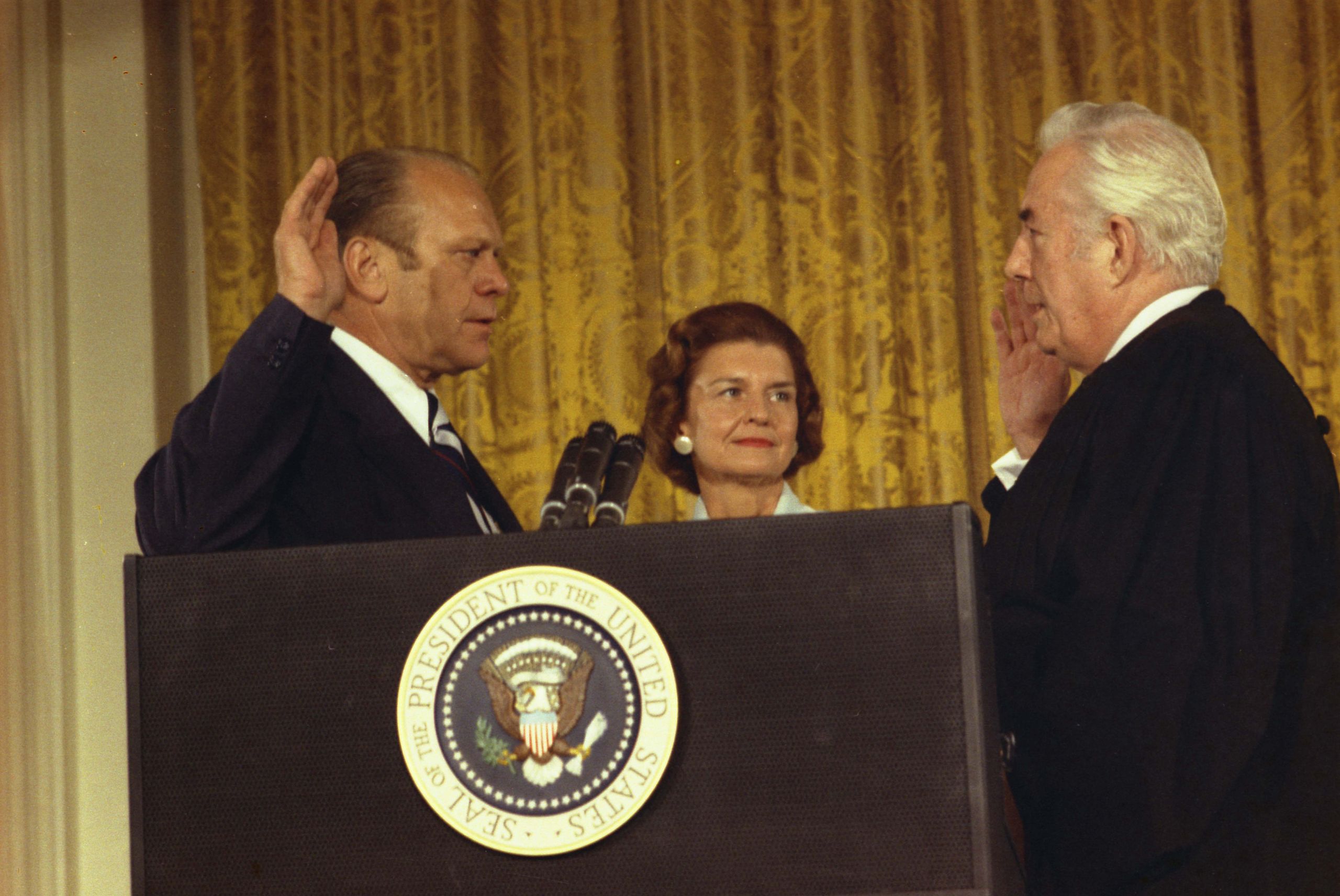
Safe Water Drinking Act Of 1974
Given his short tenure in office, Gerald Ford did not have the opportunity to build an environmental legacy rivaling that of Richard Nixon.
Ford did, however, continue the important work of his Democratic and Republican predecessors when it came to environmental protection. He supported and signed the Safe Water Drinking Act of 1974.

The Resource & Recovery Act & Toxic Substances Control Act
Ford also signed two other important environmental protection bills in 1976.
The Resource Conservation and Recovery Act, which regulated hazardous and solid wastes, and the Toxic Substances Control Act.
Unfortunately, Gerald Ford would be the last Republican President willing to take concrete actions to protect the environment.
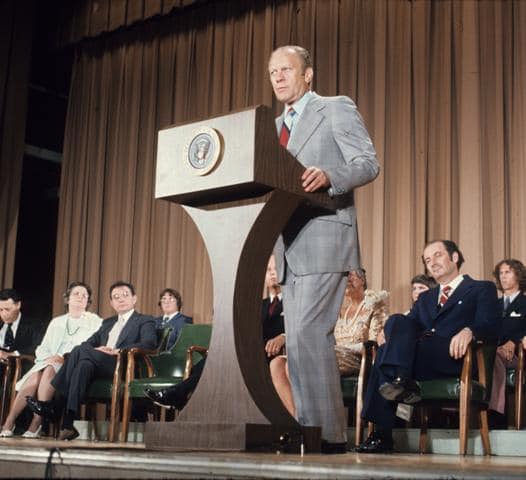
To Learn About The Man Who More Than Just Parks Considers To Be The Greatest Environmental President, Check Out Our Article
Ronald Reagan And The Republican Reversal
As James Mortan Turner and Andrew C. Isenberg note: “The Republican Reversal began in the early 1980s when Ronald Reagan broke with the bipartisan consensus on the importance of environmental protection.”
Reagan became the leading Republican proponent of a conservative ideology which advocated creating an American economy unfettered by government regulations. For Reagan Republicans, it became a dichotomy of “jobs versus environmental protection.”
One of the primary tenets of this new approach was a growing suspicion of scientific research whenever it pointed to constraints on the free market economy.
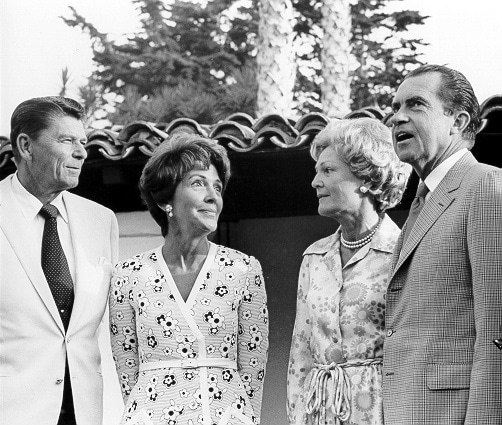
“His [Reagan’s] campaign demonstrated many of the facets of the emerging conservative politics of the environment:
–James Morton Turner & Andrew C. Isenberg, The Republican Reversal: Conservatives And The Environment From Nixon To Trump
a defiance of fact-based science and a reflexive view that government regulation was both laughably ineffective and, in its restraint of the market, an affront to property rights and entrepreneurialism.
Reagan paid no price at the polls for his hostility to the concerns of environmentalists: he received 51 percent of the popular vote for president.”
Attacking Environmentalism Became Good Politics
James Morton Turner and Andrew C. Isenberg attempt to answer the question of what happened to the Republican commitment to the environment in their book titled, “The Republican Reversal: Conservatives and the Environment from Nixon to Trump.”
In it, Morton and Isenberg write, “The economic anxieties of the 1970s presented conservatives with an opportunity to accomplish what had long eluded them: win the White House. Republicans began reversing many of their positions on environmental protection.
Reagan, largely focused on the toxicity of government regulation and the blessings of American free enterprise, added caustic dismissals of environmental regulation to his campaign speeches, inaugurating a new partisan era of environmental politics.”
In 1981, President Ronald Reagan even went so far as to claim that trees produce more air pollution than automobiles, fueling a spate of jokes about “killer trees.”

A Playbook For Future Republican Presidents
The New York Times looked back on Reagan’s environmental record and reported that he was “lax in enforcing antipollution laws and promiscuous in making public lands and resources available to profit-making corporations.
His administration cut off much needed funding for environmental and conservation agencies. These agencies were politicized and their staffs were demoralized.”
Reagan’s actions served as the “playbook” for future Republican administrations, which would prioritize economic growth over conservation while demonizing science in the process.

George H.W. Bush and The Lost Opportunity
Ronald Reagan was succeeded by his Vice President – George H.W. Bush. After taking office, he was visited by former Presidents Gerald Ford and Jimmy Carter.
Nathaniel Rich reports in Losing Earth, that the two former presidents, one a Democrat and the other a Republican, presented Bush with the “American Agenda,” a year-long, bipartisan report on the challenges facing the country.
The report recommended making climate change a major national priority and doubling the EPA’s research budget. “Americans,” the former presidents said, “should no longer see environmental issues simply as a luxury.”
Bush ignored the report.
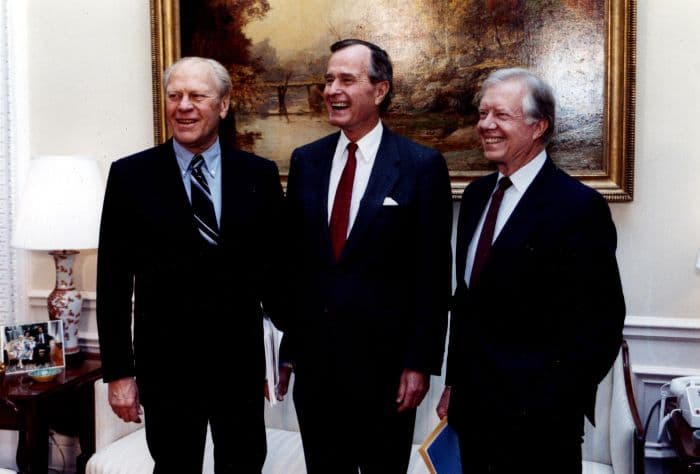
Bush, The Environmentalist?
George H.W.Bush, who had campaigned as an environmentalist, had a historic opportunity to take decisive action on climate change.
“In my first year in office, I will convene a global conference on the environment at the White House,” Bush said at the Lake Erie Metropark in 1988, adding that he would invite the Chinese, the Soviets and officials from emerging economies.
John Sununu, the President’s Chief of Staff, however, had other ideas.
Sununu was more interested in those who rejected the emerging climate science, including a number of researchers who continue to battle against consensus science today. Sununu ran his own rudimentary climate models and declared that the scientists were wrong.
So, for all his talk, Bush’s climate legacy is that he walked away from pursuing a policy that would restrict greenhouse gases at the very moment that the leading scientists in the world were saying it posed a crisis for humanity. (Source: ClimateWire)
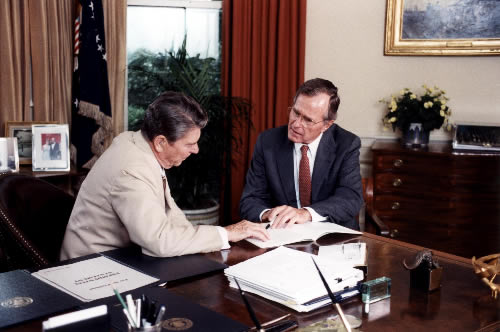
A Historic Opportunity Was Lost
The United States had a historic opportunity to use its unique position as a global superpower to commit the world to fighting climate change by setting ambitious CO2 reduction targets.
Regrettably, America failed this test of global leadership.
As ClimateWire noted, “At the start of the George H.W. Bush presidency, the Republican Party fretted about the dangers of climate change. By the end, it was focused on doubt and inaction.”
The Bush presidency was a “debate over denialism in microcosm,” said Jerry Taylor, president of the Niskanen Center and a former climate skeptic who now works to convince conservatives about the dangers of climate change.
“The GOP during the Bush presidency pivoted from a position of being torn on how to respond to climate change,” Taylor said. “This issue could have gone either way, but we know which way it went.”
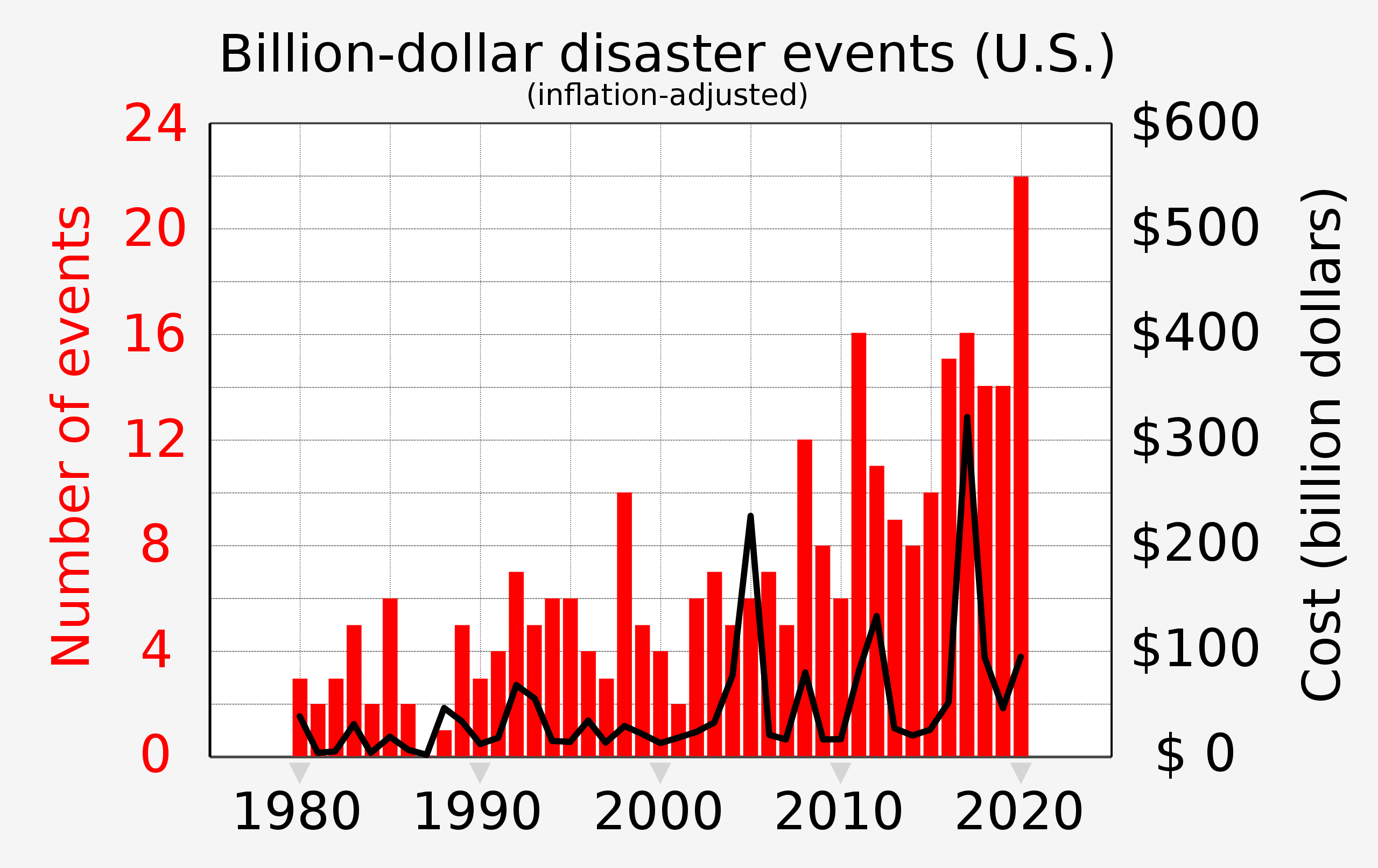
George W. Bush & More Promises Not Kept
George W. Bush, in his 2000 presidential campaign, promised to regulate and reduce carbon emissions. As President, however, he governed far differently.
“The early Reagan administration (1981–1983) launched an overt attack on the EPA, combining deregulation with budget and staff cuts, whereas the George W. Bush administration (2001–2008) adopted a subtler approach, undermining science-based policy.”
–American Journal Of Public Health, April 2018
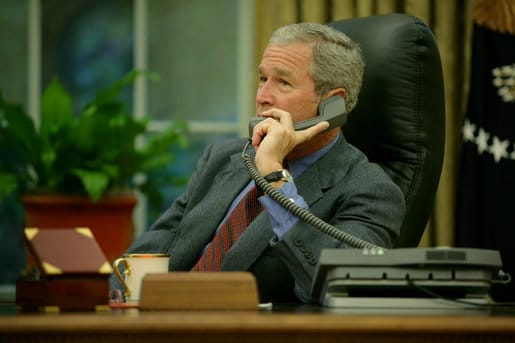
Ignoring The Looming Climate Threat
Like all of his Republican predecessors going back to Ronald Reagan, George W. Bush ignored the looming climate threat.
As a former oilman, Bush continued efforts to eliminate safety regulations and open up more public lands for coal, natural gas and oil interests.
According to the Sierra Club, “The Bush administration has introduced this pervasive rot into the federal government which has undermined the rule of law, undermined science, undermined basic competence and rendered government agencies unable to do their most basic function even if they wanted to.”
Environmental organizations concluded that the Bush years represented a concerted assault, from the administration’s undermining of the science on climate change to its dismantling of environmental safeguards to its support for mining and oil interests.
“He [George W. Bush] has undone decades if not a century of progress on the environment,” said Josh Dorner, a spokesman for the Sierra Club, one of America’s largest environmental groups.
-The Sierra Club
The 9/11 Attacks & Environmental Protection
America was attacked on September 11th, 2001. Christine Todd Whitman, who as head of the Environmental Protection Agency (EPA) under George W Bush at the time of the 9/11 attacks, told the public that the air around Ground Zero in New York was safe to breathe. She has since admitted she was wrong – terribly wrong.
Among those first responders who were exposed to toxins released when the World Trade Center collapsed, the toll of illness and death continues to rise. An estimated 410,000 first responders, cleanup crews and survivors spent days and weeks breathing in air heavy with toxins from 400 tons of crushed concrete, glass and asbestos at Ground Zero. Since that day, many continue to suffer and die as they are victims of diseases associated with the toxic cloud from the pulverized buildings and equipment.
Whitman, unlike most Republicans, made an unprecedented apology to those affected, but denied that she had ever lied about the air quality or known at the time it was dangerous.
“Whatever we got wrong, we should acknowledge and people should be helped,” she said. Remember those words because this would not be the last time a Republican Administration would ignore a looming public health crisis with catastrophic consequences. But she would be the last Republican official to admit that they [the administration] got things wrong.

The Worst Was Yet To Come
Notwithstanding Donald Trump’s claims during the 2016 campaign that he wanted “crystal clean water and the cleanest and the purest air on the planet,” a Washington Post report noted that Trump weakened or wiped out more than 125 rules and policies aimed at protecting the nation’s air, water and land during his time in office.
Trump’s most notable decision was to withdraw the United States from the Paris Climate Accords shortly after taking office.
According to CNN, in Trump’s first two years in office, the Environmental Protection Agency’s rate of deregulation was so high that an internal watchdog has said the agency “exceeded” its self-established goals. And, in the third year of his presidency, agencies, not just the EPA, continued the environmental regulation rollbacks.
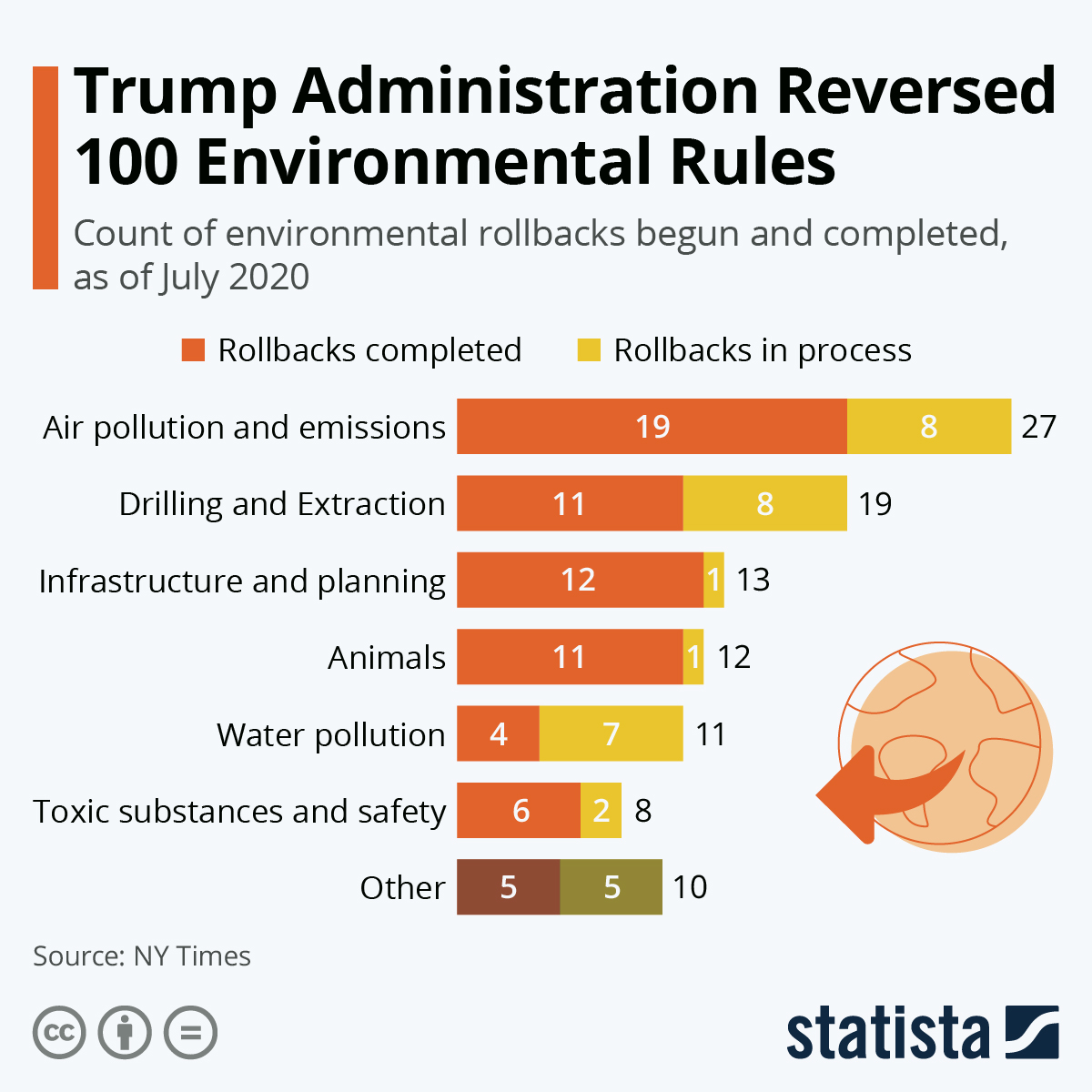
The Worst President For The Environment In U.S. History
“Trump is the worst President for the environment in our history. No amount of spin from this administration can hide its legacy of abuse, neglect and corruption that threatens our health and the health of our environment,” concluded Wilderness Society President Jamie Williams.
Williams went on to note that, in the field of conservation, “Trump’s illegal land grab, which slashed Bears Ears and Grand Staircase-Escalante national monuments in Utah, was the biggest single rollback of land protections in American history. And that’s just one low point in an abysmal record of attacking the most cherished places in the country, from the Arctic Refuge in Alaska to Minnesota’s Boundary Waters.”
In the final weeks of his presidency, Trump continued to push through dozens of environmental rollbacks weakening century-old protections for migratory birds, expanding Arctic drilling and hamstringing future regulation of public health threats.

Trump’s Environmental Policies Killed Thousands
A comprehensive assessment of the health and environmental impacts of Donald Trump’s presidency was issued by 33 leading scientists in a major report by Lancet. They concluded that rollbacks of environmental and workplace protections led to 22,000 excess deaths in 2019 alone.
“Basically, the Trump administration stopped enforcing Clean Air Act,” said Philip Landrigan, a pediatrician and epidemiologist at Boston College who was one of the report’s co-authors.
Under the aegis of ending the “war on coal,” Trump’s Environmental Protection Agency reversed the Obama administration’s emissions rule and stopped trying to control fine particulate matter air pollution.
As a result, the Lancet report said, concentrations of such pollution have increased after having declined steadily for decades before he took office.

A Republican Rejection Of Science
This new partisan era in environmental politics has meant more than just a rejection of the science of climate change by one of our two major political parties. It’s also meant a rejection of science altogether as the Trump Administration’s handling of the Coronavirus Pandemic clearly demonstrates.
According to the Washington Post, reports show that as early as January of 2020, the president was advised by both his own experts and the intelligence services of the need for urgent mitigation measures against the spread of the virus.
While Donald Trump acknowledged the dangers of the coronavirus pandemic in an interview in February of 2020 with journalist Bob Woodward, his initial response was to do nothing. At least 38 times Trump stated that Covid-19 was going to “just disappear” despite knowing this was not the case.
Lives Would Have Been Saved Had Republican Leaders Done The Right Thing
Anthony S. Fauci, the director of the National Institute of Allergy and Infectious Diseases, has stated that, had proper public health guidelines been implemented earlier, a crucial period in the exponential spread of the virus would have been mitigated and American lives saved.
Leading epidemiologists have put a finer point on this, estimating that 50 to 80 percent of covid-19 deaths in New York and approximately 90 percent of all American covid-19 deaths can now be attributed to the Trump Administration’s delay. (Source: Washington Post)
President Trump even went so far as to make the outrageous claim, without any substantiation, that U.S. doctors were lying about the number of Americans who’ve died from Covid-19. Trump claimed they inflated the figure because they were paid more money for deaths attributed to the virus.
In short, the Republican rejection of science had lethal consequences for thousands of Americans.

It’s All Part Of A Larger Pattern
But it’s all part of a larger pattern from Ronald Reagan’s claim that trees cause pollution to Donald Trump’s contention that the coronavirus would just disappear. Sadly, this rejection of science has come to dominate the Republican Party’s thinking in the 21st century.
It’s even gone to absurd lengths with Texas Senator Ted Cruz taking aim at Sesame Street’s Big Bird for promoting COVID-19 vaccines for kids. Cruz has called it “government propaganda . . . for your 5 year old” after the canary-like 8-foot 2-inch Muppet proclaimed that he’d gotten the jab.
Or then there’s former Republican Governor Mike Huckabee’s line of children’s books which are centered on American history, social issues, and other hot-button topics. One such book, The Kid’s Guide to the Truth About Climate Change, may acknowledge that we’re experiencing changes to our climate, but it actively minimizes what humans’ impact on these changes are.
The book adheres closely to a particular political perspective by encouraging young readers to approach the issue with skepticism toward their teachers and others, accusing them of having hidden agendas. (Source: Washington Examiner)
The end result of these misguided and harmful efforts can be seen in a Forbes 2021 survey which finds that Republicans have less confidence in science by nearly a third since 1975.
Democrats are 34 points more likely than Republicans to have confidence in science, a wide partisan split that did not exist in 1975, when GOP voters (72%) were actually 5 points more likely than Democrats (67%) to have confidence in science.
Can Republicans Shift On Climate Change?
So, How Do We Fix The Problem? The Curious Case Of Richard Nixon
It’s worth taking a closer look at the curious case of Richard Nixon if we’re interested in learning how we might get Republicans to start taking climate change seriously. Nixon was the quintessential political animal. He did what made good political sense, which is why, unlike Donald Trump, he was reelected.
As James Freeman Clarke once noted, “A politician thinks of the next election. A statesman, of the next generation.”
Unfortunately, our electoral system produces more of the former than the latter. So, what is the solution?
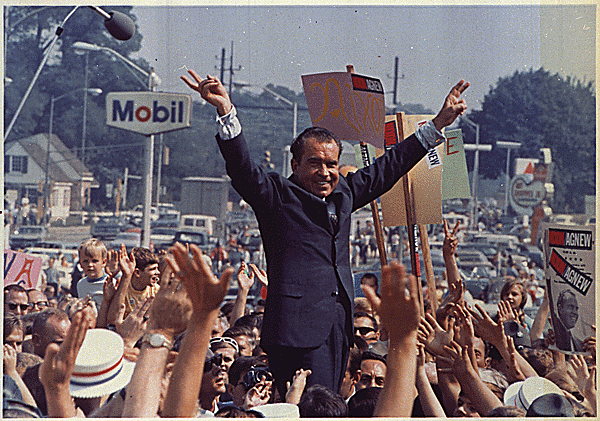
The Answer My Friend Is Blowing In The Wind
Bob Dylan once wrote the “answer my friend, is blowing in the wind.” Only in this case, the proverbial winds were political.
If you study the career of Richard Nixon then you’ll discover that he was an ardent anti-communist in the 1950s and early 60s. Why? Because, at the height of the Cold War, anti-communism was a popular political position and one which helped to launch Nixon’s own career.
Why did Nixon, the arch anti-communist, become the man who recognized the largest communist country on earth? The answer is simple. By the 1970s, the political winds had shifted. So Richard Nixon shifted too.
In 1971, Nixon was trailing for reelection against some of the prospective Democratic candidates. Trailing in those early polls, he opened the door to China to serve his reelection needs first and foremost.
Nevertheless, it was still a good policy decision as it began the process of reforming China’s economic system and consequently helping to spur the global economic growth which China accounts for today. It also gave the Chinese a strong economic incentive to begin promoting economic opportunities around the globe.
Given the strong support for the environmental initiatives of Nixon’s Democratic predecessors, his own environmental initiatives were simply good politics. In the 1970s, it was what the public demanded from their elected officials.
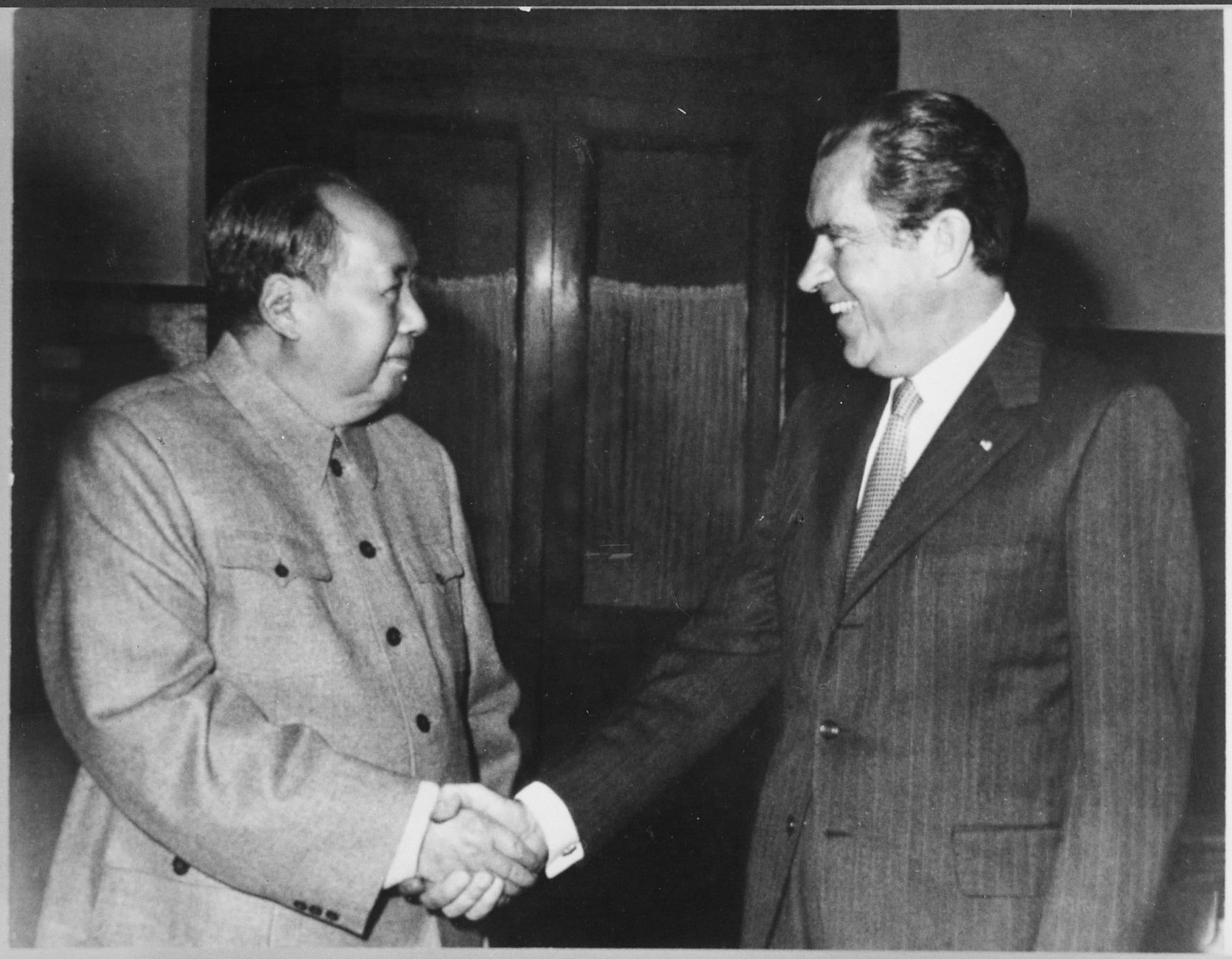
That’s How We Explain Nixon’s Shift
Richard Nixon’s singular preoccupation with politics and what it would take to win also involved him in the worst political scandal of the twentieth century. It’s a scandal which forced him from office and forever tarnished his legacy.

And yet, the same Richard Nixon ranks as one of the greatest, some would argue the greatest, environmental president of all time.
In both the Watergate Scandal and Nixon’s Environmental Agenda, his actions were driven by political considerations. That’s how we explain the conundrum of how his political corruption contrasted with his environmental progressivism.
Solving The Problem Requires All Of Us – Democrats & Republicans (And Independents Too!)
The curious case of Richard Nixon illustrates both the problem and the solution to our current dilemma.
For Richard Nixon, tackling the environmental challenges of his time was smart politics given the widespread public support for environmental initiatives.
Today, we need to once again show elected officials, of both political parties, that it’s smart politics to do what Richard Nixon did back in the 1970s.
Of course, this means that Republicans must overcome their distrust of science. If Republican voters demand science-based policies then Republican leaders will respond. And if the current crop of GOP leaders don’t then a new crop of more politically-savvy leaders most certainly will.
According to the Greenly Institute, as of 2021, 58% of Republicans still don’t view climate change as a priority – and 44% of Republicans still believed that climate scientists have placed too much emphasis and influence on climate policy debates. This has got to change.
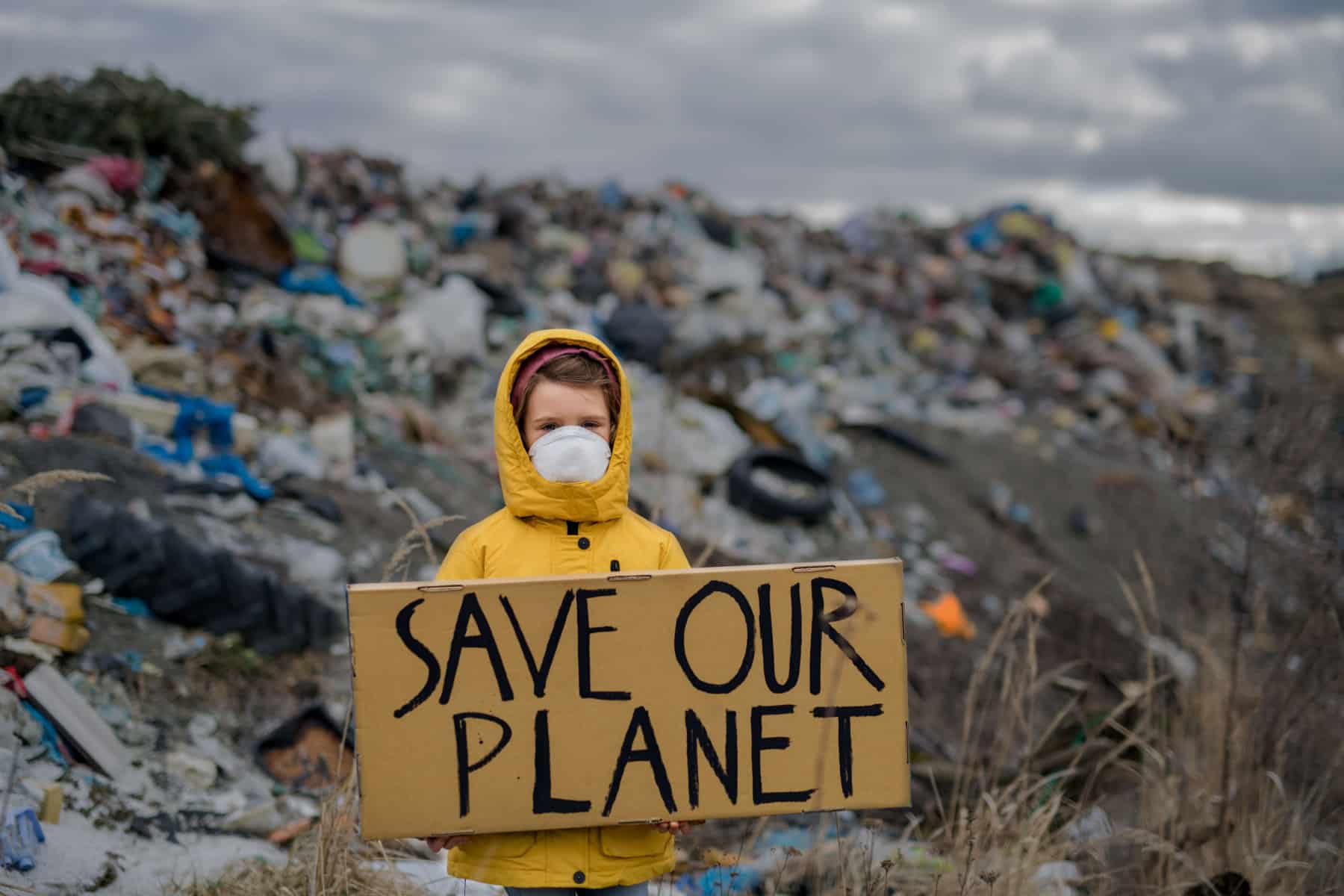
We’ve Got To Have Public Support For Environmental Protection Or It Won’t Happen
Once upon a time, industry had to walk the fine line between trying to protect profits and protecting the environment in the eyes of voters and consumers. This was during the 1960s and 1970s when voters from both political parties cared about environmental protection.
William Ruckelshaus was the first director of the Environmental Protection Agency. The clean air issue reinforced Ruckelshaus’s view that the EPA’s effectiveness depended on popular support.
A highly motivated public creates the political support necessary for bipartisan cooperation on environmental issues.
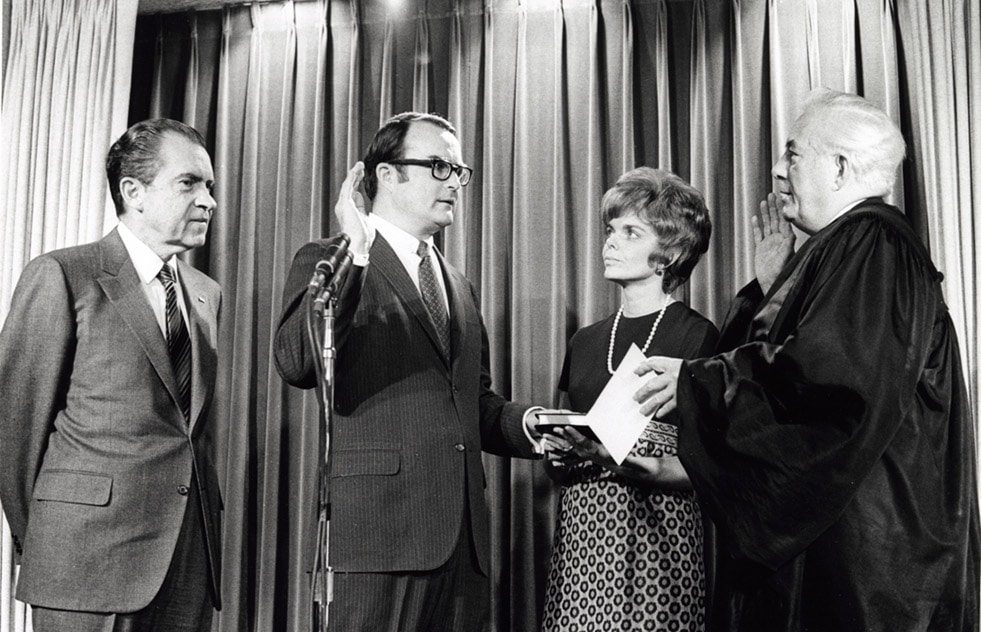
“You’ve got to have public support for environmental protection or it won’t happen,” asserted Ruckelshaus. Simply put, that’s the moral of the story!
Change Only Happens When Enough People Demand It So Be The Change
Wanting change is an essential first step, but to bring about real change in a democratic society, active participation through voting is crucial.
Voting is a fundamental right and responsibility for citizens in many countries, and it plays a significant role in shaping the direction of government policies and the overall society.
Here are some reasons why voting is important:
- Representation: Voting allows you to elect representatives who will make decisions on your behalf. It ensures that the government reflects the will of the people.
- Influence Policy: By voting, you can help determine the policies and laws that govern your country, state, or local community. Your vote can directly impact issues that matter to you.
- Voice for Marginalized Communities: Voting provides a platform for marginalized communities to have a say in the political process and advocate for their rights and interests.
- Change through Peaceful Means: Voting is a peaceful and democratic way to bring about change. It reduces the likelihood of resorting to violence or other extreme measures to express dissatisfaction.
- Accountability of Leaders: When you vote, you hold politicians accountable for their actions and decisions. Elected officials know that they need to listen to their constituents’ concerns if they want to be re-elected.
- Preservation of Democracy: Voting is a foundational pillar of democracy. A strong and active electorate ensures that democratic institutions remain strong.
- Civic Duty: Voting is not just a right; it is also a civic duty. It is a way to contribute to the betterment of society and fulfill your responsibility as a citizen.

Climate Change Doesn’t Care Whether You’re A Republican Or A Democrat
According to the Pew Research Center, the share of Americans who consider dealing with global climate change a top priority has increased from 38% to 52%. This indicates a significant upward trend in the recognition of climate change as a critical issue.
The change in attitudes towards climate change as a top priority is more pronounced among Democrats and independents who lean towards the Democratic Party. Among this group, 78% now view climate change as a top priority, reflecting a 22-percentage-point increase since 2016.
In contrast, there has been no statistically significant increase in the prioritization of climate change among Republicans and Republican-leaning independents over the same period.
But Climate Change doesn’t care whether you’re a Republican or a Democrat. It’s an issue that affects all of us. Addressing climate change requires bipartisan cooperation and support to implement effective solutions. Bridging the partisan gap on this issue is crucial to develop sustainable and impactful policies to combat climate change effectively.
In other words, it’s up to all of us.
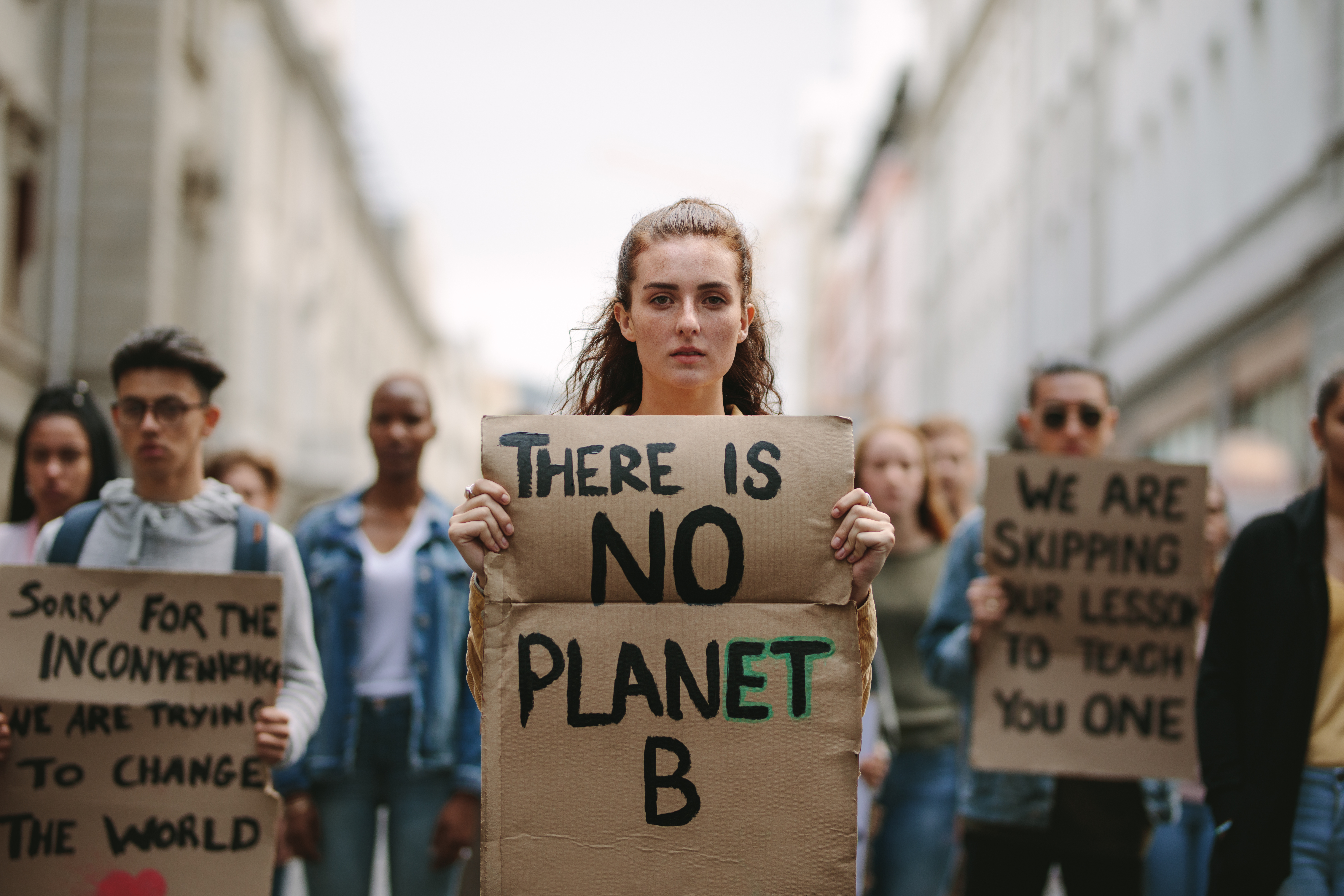
“Probably on any given problem of modern life, if a count or classification could be made, the out-and-out conservatives would be found to be in a distinct minority.
-Franklin Delano Roosevelt, delivered on May 8, 1926 at the Milton Academy
Yet the majority would be so divided over the means by which to gain their ends that they could not present sufficient unity to obtain action.
This has been the history of progress.“
About The People Behind More Than Just Parks
We’re Jim Pattiz and Will Pattiz, collectively known as the Pattiz Brothers (and sometimes as the “Parks Brothers”) and along with our dad (a retired history teacher) we love public lands.
You should probably know that we don’t just make this stuff up out of thin air. We absolutely LOVE America’s public lands and have spent our entire adult lives bringing these places to life through our amazing short films.
We’ve worked with the National Park Service, the Department of Interior, USDA, U.S. Forest Service, and more for years creating films on important places and issues. Our work has been featured in leading publications all over the world and even some people outside of our immediate family call us experts on the national parks.
And, in 2018, our father – having spent a lifetime teaching history – joined us so that he could help us to tell the incredible stories behind these amazing places.
Meet The Parks Brothers
We Hope You’ll Follow Our Journey

Our goal here at More Than Just Parks is to share the beauty of America’s national parks and public lands through stunning short films in an effort to get Americans and the world to see the true value in land conservation.
We hope you’ll follow our journey through the parks and help us to keep them the incredible places that they are. If you’re interested in joining the adventure then sign up below!
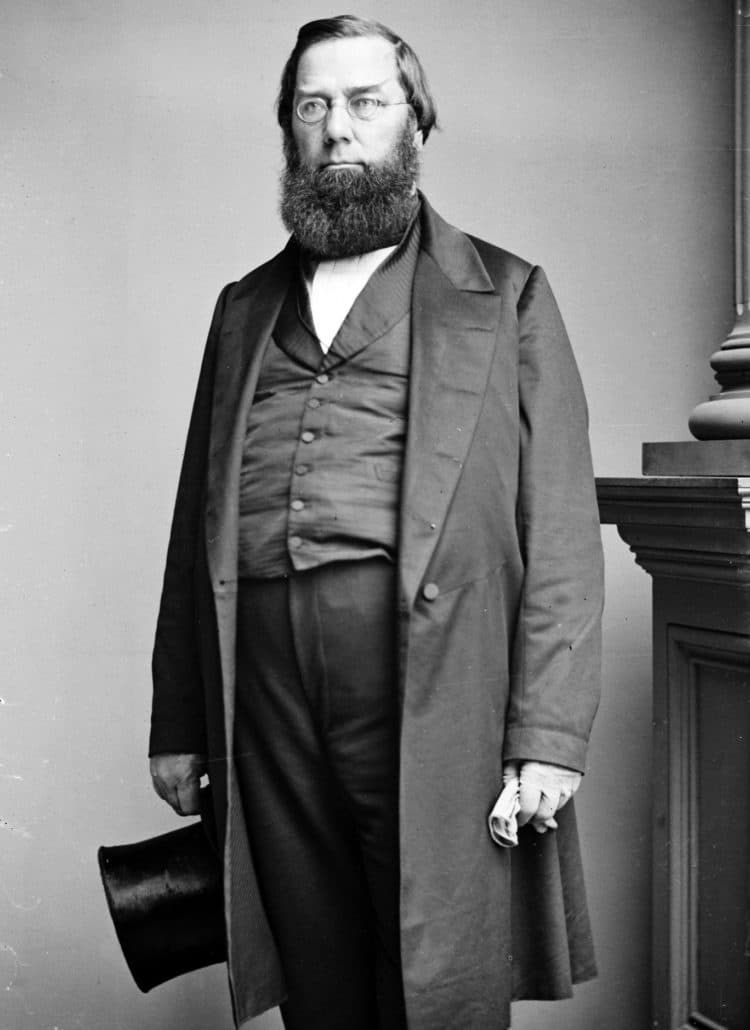




Leave a Reply